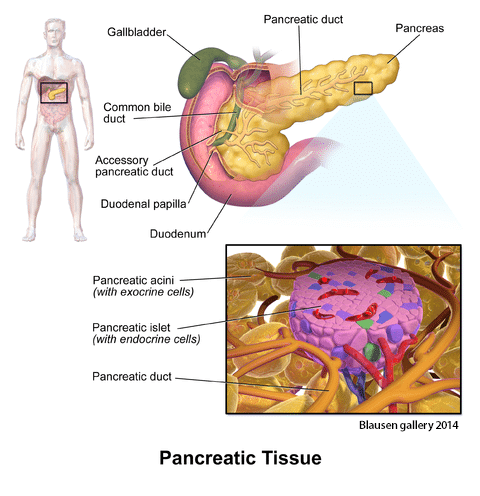Your pancreas is an essential part of your digestive system. It produces certain chemicals that help to properly digest the foods you eat. Discover more about how your pancreas works and what that means for people with diabetes.
-
- The pancreas is a 6 to 10 inch gland organ that is shaped like a fish and extends horizontally across your abdomen. The pancreas produces hormones and enzymes to help break down and digest the food you eat. The endocrine part of the pancreas is made of cells that secrete hormones into your blood. One of those hormones is insulin, which is secreted by pancreatic beta cells to handle rises in blood sugar. Inflammation and other symptoms signal disorders associated with the pancreas such as diabetes as well as pancreatitis, cystic fibrosis and cancer. To help maintain a healthy pancreas, you should eat a well-balanced diet, avoid smoking and limit or eliminate alcohol consumption.
- Enzymes secreted by the pancreas digest the foods we eat. Chymotrypsin and trypsin digest proteins while amylase breaks down carbohydrates and lipase breaks down fats. Insulin is secreted by pancreatic islets (islets of Langerhans) to handle a rise in blood sugar. The hormone moves glucose from your blood into your tissues and muscles to use for energy. It also helps your liver absorb glucose, which is stored as glycogen for your body to use during exercise or stressful moments. When there is a decrease in blood sugar, glucagon is released by your pancreatic cells to help restore blood sugar to a normal level. People with diabetes have a deficiency of insulin, which is found in the endocrine tissue of your pancreas.

- In people with type 2 diabetes, the pancreas produces insulin but the body is not able to use it. Insulin resistance occurs when the muscles, liver and fat cells do not respond properly to insulin. The pancreas attempts to keep up with the need for more insulin but ultimately fails. Glucose builds in the bloodstream and damages beta cells, which further reduces the ability of the pancreas to make insulin. Treatment of type 2 diabetes may include the use of insulin and/or oral medications. Patients should exercise at least 5 times a week for a minimum of 30 minutes each day. A balanced diet includes proper portions of whole grains, lean meat and fish, fruits and vegetable and low-fat dairy.
- In type 1 diabetes, the body’s immune system attacks and destroys the pancreatic cells that produce insulin. Patients take lifelong insulin injections or use an insulin pump to control blood sugar. They also need to eat a healthy diet and exercise regularly.
- People with type 1 and type 2 diabetes should check their blood sugar levels throughout the day and record the results to share during routine medical appointments. A blood sugar monitor and Glucose test strips are typically used to check blood sugar levels. Any extreme high or low readings should be reported to your doctor immediately. You should discuss with your health care provider how many times you should be testing a day.
- Medical professionals can perform various tests to check your pancreas. During a physical exam, the doctor might press on the center of your belly to check for a mass. A computed tomography (CT) scanner takes x-rays and computer-generated images of your abdomen and pancreas. Magnetic resonance imaging (MRI) is also used to take images of the pancreas. A MCRP takes images of the pancreas, liver and bile system. Other tests that may be used to check the pancreas are endoscopic retrograde cholangiopancreatography (MCRP), pancreas biopsy and ultrasound as well as genetic testing, sweat chloride tests and blood tests.
Knowing how your pancreas works helps you understand how diabetes has an impact on your body and well-being. People with diabetes should take insulin and medications as prescribed. It is also essential to eat a well-balanced diet and exercise regularly for optimum health.






Leave A Comment